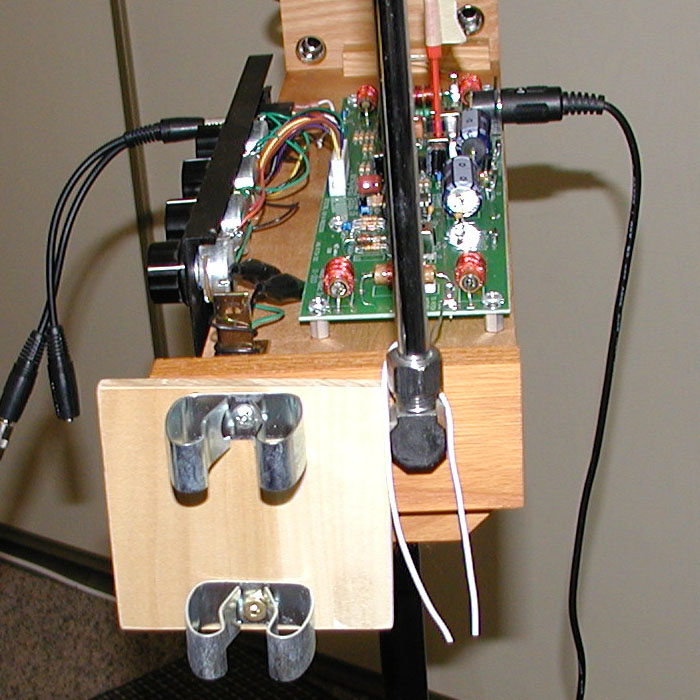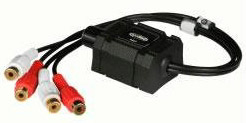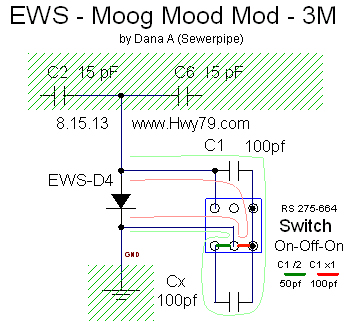Purchase a finished EtherWave Standard
board for
$96, add my $50
modification and you will have a theremin better in design & sound than Clara
Rockmore - That's
Priceless
- Have
the full range of classic theremin sound from beautiful flute to Clara to
violin -
This
webpage below is about
things the everyday EWS
owner should become comfortable with... as your local TV repair shop is
not
going to be
of any service to you and will take your money anyway. They replace boards
which you could do!
Never
use black paint your EWS wood enclosure, the carbon can have terrible
effects on performance!
If your EtherWave
Standard has been in storage for several years you
should buy a quality potentiometer cleaner like
DeoxIT
Fader Lube and
spray each Pot to clean up the contact surfaces. This is the first area to
go bad in an EWS due to environment and time, do
not adjust any coils
until you clean the Pots. Do
Not Use
WD40
on your Pots as this will gum them up and leave a film that traps dust over time.

Notice the wire loop around the base of the
antenna:
This 8" (20cm)
wire trick looped around the antenna base is temporary and used
when tuning with the wood cover is off. Remove the wire loop when the cover is placed back
on, this avoids the need to drill holes for retuning.
The wire can also be a temporary
fix when the Null
Point is too close to the antenna,
a tight pitch field. The wire pushes the Null point away from the antenna,
so twist and snip a little shorter to move Null
towards the antenna, a little longer to push Null away from the antenna.
Ignore my Agua Bella clamps
next to the antenna, that's another webpage. The EWS
can be much more, I am exploring how to get a natural
new voice .mp3 using acoustics. This could use some polish but
it is still very interesting, what do you think? I say enough of that
Jimmy Page puny
whistle stuff. LOL
Visit
My Using Acoustics with an EWS
.
|
Hot
- EtherWave Audio Signal? Use
this inline Attenuator $6
Drive any amplifier,
keyboard or guitar, effects, etc. You will need adaptors for the
RCA ends. |
|

|
 |
.This $5 Bass Mod
can be done without hacking the board!
This $5
trick at the left smoothes the EWS sound into something rich and beautiful. These
clips are a bit to large but a good way to test different capacitor
values. My choice is a 82pf capacitor solder tacked across the D4 diode.
For myself the authentic
theremin sound is like this sample below. No puny whistle or phony digital synth sound buried in
reverb, you are better off getting that from a keyboard.
. |
| Jumping D4
reduces coupling between oscillators by attenuating some of
the RF signal from both oscillators to ground. This method also
reduces the Hot EWS output with a smoother sound. It is a
myth that a bass mod could improve pitch linearity. It just gives
you an extra lower octave or two. |
 |
The photo above left shows
temporary clips holding either a 47pf or 100pf in place. Solder
the cap you select from the top side of the board on each side of
the diode. The 100pf gives the smoothest low
end, maybe too smooth. I prefer a 82pf capacitor. This
added cap also tames a Hot EWS Output.
Now
about the 3M switch
You might use
Radio Shack switch
on-off-on and have three sound possibilities using two 100
pf capacitors. Original, Mellooow and somewhere in the
middle.
Radio Shack
< $5 Here is the
budget EWS sound mod using 100pf across D4, I like 85 pf so not so
smooth on the upper end.
bella-pitch-mod.mp3
Nothing
in this is critical other than physical stress on the diode, keep
the added wire length short, less than 7" (175
mm).
The switch
could mount downward behind the Waveform control out the bottom of
the wood box. Thread it through a snug drilled out hole. The Mod
has no specific direction so connect it either way.
|
Have
the EWS mounted on a Mic Stand or sitting on top of a cardboard box before
making any adjustments. The sensitive volume loop and pitch antenna must
be clear of surfaces and at least 5-feet from large metal objects. Set
all front panel knobs to half way.
|
Tuning
Your EtherWave
Standard is something every Thereminist should become familiar.
Avoid
adjusting L5 if you do not have a frequency
counter. This needs to remain tuned (~286khz)
to match the antenna circuit.
A well tuned EtherWave can have excellent linearity and a
good sound,
not Clara Rockmore, that's another webpage.
Adjusting the Null Point
Location: Have the Pitch knob set half way. To compensate when the
wood cover is off of the EWS place the 8"
white wire loop
(see above photo) around the base of the antenna.
Adjust L6
in the middle of the pc board (Not
L5 on the right)
to set the proper distance of the Null Point.
L6 adjusts the
Null Point
distance to the Pitch Antenna
by matching L5 (286khz)
in frequency exactly.
Remove the 8" white wire
loop from the antenna after the wood
cover is placed back on.
L11 is adjusted after
all else is done for the proper Volume Control response. Remove C28
jumper, somewhere in the middle of the tuning range, you should hear the sound start to be audible, reach a maximum
loudness, and then die off again. Turn the lug back to the point where the
sound is loudest. Your hand approaching the volume loop should quiet the
sound now.
To Bypass
the Volume Loop control temporarily, place a jump wire (alligator clip
lead) across (short)
C28 for continuous sound.
Touching the
test probe to tuned circuit sections directly might load down that circuit
giving a false reading.
Have the folded
over 8" white wire seen in the above photo on the antenna in place while the cover is
off.
|
Here
are some general frequency
test points, connect the black test
lead to ground.
All
measurements are with the EWS Control Panel facing you. |
| With the plastic
part of the meter red probe held next to the pitch Antenna you should
get about 286 kHz. |
L5
Oscillator if working you will get about 286 kHz off the top
side of L12 with direct probe contact.
The
meter indicated is sensitive enough to pick up the RF signal with
the red probe two feet away from the pitch antenna. |
| L6
Oscillator if working you want around 286 kHz off the left side L13
with direct probe contact.. |
L11 Drape the
red probe cord over the Volume Loop, no direct contact. You should
measure about ~498
kHz.
Do
not mistake a 286 kHz reading from the Pitch Field as the Volume
~496 kHz reading, hold the pitch antenna to disable it.
|
Using a frequency
counter is best and Amazon has
many. This $15 bargain Multimeter
with 10 MHz counter
works great. It arrived from
China in
7 days by regular snail mail with free shipping to my home in California.
It uses a single 9v battery not included.
It is at ~
286 kHz that the factory tuned EWS develops the most linear
pitch field on the later designs. The
adjustable hex head on the L5, L6 & L11 is 5/64" (2mm)
on latest models.
Earlier EWS models use
around 260 kHz for the pitch oscillator.
This meter can also
work as a Pitch
Tuner if
you install your own Pitch Preview jack.
Reach for 440
hz or any musical note frequency
for an instant reading.
|
 |
Most EWS owners
don't have a counter? Using an AM Radio
can work for minimal frequency verifying but not recommended.
An analog AM Radio placed next to the pitch antenna can
be a
useful tool to determine if the RF oscillators are working.
If you tune an Analog
AM Radio to 858 kHz
which is triple the 286 kHz
fundamental freq you will hear a whistle or blank spot
over the AM Radio. Lightly tapping
your finger
on the top Q1
the antenna side or Q3
the fixed pitch oscillator will shift the freq
slightly which makes it easier to find as you tune the AM Radio to the
right spot.
This is a quick test to see
if the main oscillators are working when no sound is heard at the audio
output jack. This is listening before the audio Op amp and the volume control section.
If you found the analog
theremin whistle response over the analog
radio you can verify with even better accuracy the theremin operating
frequency by switching to a Digital
AM Radio set to 860
kHz
and see if you find the theremin response.
Before adjusting anything you
must determine if the Fixed and Antenna Pitch oscillators are at already
at ~ 286 kHz.
If it is do not touch L5
which is the coil closest to the antenna, this
is tuned to the frequency of the antenna circuit.
Only adjust L6
in the center of the board, to set the proper Null
distance with the pitch knob set
halfway.
Turning L6
CCW raises the RF frequency along with the audio frequency, only do 1/4 turn adjustments without every
getting out of the range so you always hear heterodyning tone over the radio.
The digital radio will
not demonstrate any
noticeable theremin signal or audio sound unless heterodyning is occurring, this is
the down side to using a digital radio but it will give a more accurate
frequency reading than an analog AM Radio. Heterodyning is heard when L5
& L6
are approximately the same frequency.
The digital radio window is
10 kHz wide, if you don't have a frequency counter you want to tune L6
to move the operating freq to
the bottom edge of the detected signal at 860
kHz on the digital
radio display.
The ideal frequency
for the EWS is to adjust L5
& L6 to about 286
kHz
which can be listened to at 858 frequency harmonic on the digital AM Radio display.
L11
is adjusted to get the proper volume response "after" L5 & L6 are
properly set to your liking. Somewhere in the middle of
L11 you should hear the sound start to be audible, reach a maximum
loudness, and then die off again. Turn the lug back to the point where the
sound is loudest. Your hand approaching the volume loop should now quiet the
sound.
If the pitch
oscillator stalls
out, (stops
working) have the Pitch
Tuning Pot set to 1/2 way, then turn L5,
which is closer to the antenna slightly (1/4
turn) clockwise and see
if the oscillator runs reliably, then readjust L6
to return the Null Point setting. L11
may then need another tweak
Finish the
fine tuning of the
antenna circuit by bending the connecting
wire more or less,
away from the grounded foil. This changes the static capacitance ever so slightly.
Bending it towards the foil normally spreads the inner field out a bit in
the higher octaves. Experiment with bending it slightly, you may not
notice any change. 0-:
One source of the EWS tuning tool is the "Trituner"
and it can be ordered directly on Coilcraft's website Thierry
http://www.coilcraft.com/
tools.cfm
This tuning tool is a
5/64" (2mm)
hex head and a must have if
you lost the one that came with your instrument.
Visit: Visit
Using Acoustics with an EWS
Did
you know Lev Sergeyevich Termen was a Professor of Physics at Moscow State
University (Department
of Acoustics) developing
his inventions and supervising graduate students.
|